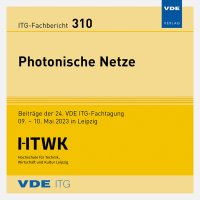Ultra-compact Forward-biased Silicon Modulators for Energy-Efficient Interconnects
Conference: Photonische Netze - 24. ITG-Fachtagung
05/09/2023 - 05/10/2023 at Berlin
Proceedings: ITG-Fb. 310: Photonische Netze
Pages: 5Language: englishTyp: PDF
Authors:
Dev, Sourav; Catuneanu, Mircea; Vithalani, Hrishikesh; Zarif, Arezoo; Jamshidi, Kambiz (Integrated Photonic Devices Group, TU Dresden, Germany)
Singh, Karanveer; Hosni, Mohamed I.; Schneider, Thomas (Terahetrtz-Photonics Group, TU Braunschweig, Germany)
Abstract:
Large-scale integration has become the key to meet the increasing demand for data communication. Moreover, to provide high speed and energy efficiency together as compensate for the scaling bottleneck, the research preference is shifting towards the electro-optic domain. For applications like data center interconnects, silicon electro-optic modulators have become important blocks to fabricate integrated circuits. Silicon Mach- Zehnder modulators (MZM) and silicon micro-ring resonators (MRR) are of great interest in this regard. Different parameters have been studied over time to study the performance of these modulators. They include the phase-shifter length, power consumption, modulation efficiency (VpiL), extinction ratio (ER), modulation speed, etc. Several modeling has been studied and several designs have been fabricated, which have been characterized experimentally in the lab to increase the modulation speed and ER while maintaining the power consumption, insertion loss, and VpiL to a minimum level. Because it can achieve a higher level of integration and lower VpiL compared to the reverse-biased configuration, our focus mostly remains on forward-biasing. In this paper, we review our attempts to optimize different parameters of silicon modulators to utilize them for various applications. These silicon modulators pave the way to more aggressive scaling and have already been successfully utilized as frequency comb generators and Nyquist pulse generators.


